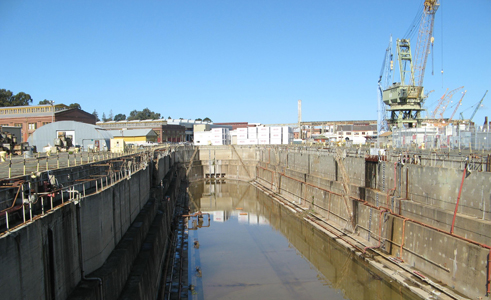Petaluma-based Allied Defense Recycling (ADR) has announced ambitious plans for 16-plus acres of the former Mare Island Naval Shipyard in Vallejo.

Plans for the former Mare Island Naval Shipyard in Vallejo include establishing a full-service marine-related facility on 16.6 acres. The facility will be operated by Allied Defense Recycling. Services will include maintenance, repair and dismantling of large ships. The facility will be the first of its kind on the West Coast. Photo courtesy of San Francisco Bay Conservation & Development Commission
By Bill Picture
Published: October, 2010
With all eight of the necessary permits and approvals in its back pocket, ADR is waiting for a thumbs-up from the federal government. The project’s future, however, hinges on the awarding of a federal ship-dismantling contract from the Maritime Administration (MARAD), the division of the U.S. Department of Transportation that oversees waterborne transportation.
“The next step is for MARAD to confirm ADR as a qualified bidder and issue the bids,” said ADR’s attorney, Oakland-based Rena Rickles.
Retired federal vessels must now be sent to a facility in Brownsville, Texas, for dismantling. According to ADR and its supporters, the proposed “West Coast option” is greener, more efficient and will save millions of taxpayer dollars.
“Right now, the ships are towed to San Francisco, where the exterior paint is removed, then towed 5,000 miles through the Panama Canal to Texas,” Rickles said. “The trip takes 200,000 gallons of diesel fuel. That’s a pretty big greenhouse gas footprint, not to mention expensive.”
“And the environmental regulations in Texas are a lot more lenient than in California,” said Karen Weiss, one of five permit analysts at the San Francisco Bay Conservation and Development Commission (BCDC).
Dismantling federal ships on Mare Island would cost taxpayers about $1 million less per ship than sending them to Brownsville. The ADR facility would not be able to handle the largest vessels, however. Those would still need to be sent to Brownsville for dismantling.
Living up to California’s green standards
In order to secure the necessary permits, ADR had to prove that its plan would protect both public health and the environment. To that end, work at the proposed facility would be done entirely in hermetically sealed chambers to prevent the release of lead, asbestos and other toxic materials. Furthermore, the work would be done in the early morning hours, when winds in the area are lightest. Metal would be shipped off to scrap metal recycling facilities, and toxic materials would be hauled off in sealed containers for processing and disposal.
The permitting process also involved working with three separate agencies to ensure the protection of those species of fish native to the waters surrounding Mare Island.
“There are several endangered or threatened species that go through that area,” Weiss said. “There were concerns about the impact that dredging might have on those species, and that the fish might get caught in the dry docks’ uptake valves. Naturally, those concerns had to be addressed before the project could move forward.”
To ensure that juvenile fish aren’t sucked up by a hydraulic dredge, ADR agreed to use a mechanical dredge for the bulk of the dredging. They also agreed to limit maintenance dredging in the future, and to perform dredging only during daylight hours as salmon tend to spawn at night. ADR also plans to remove a fish migration barrier, to restore a salmon spawning streambed in the nearby Napa River watershed, and to enhance and preserve five acres of adjacent tidal wetland.
A boost to the local economy
Rickles estimates that the project would create one hundred permanent union jobs. “Dismantling a big ship is no small fete,” she said. “And that’s not taking into account the ripple effect on Vallejo’s economy, because those employees will be supporting other local businesses.” “The City of Vallejo is excited to see this happen,” added Weiss.
City officials are also excited about the promise of improved public access on the island. There currently is no public access on or near the site. As part of ADR’s agreement with Vallejo, the company would build a public access area that overlooks the facility, and that can eventually be connected to a proposed new segment of the Bay Trail.
“It’s a win-win for Vallejo,” said Rickles. “We’re ready to move forward. We’re just waiting to see what MARAD comes back with.”

